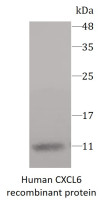ARG70427
Human CXCL6 recombinant protein (Active) (His-tagged, N-ter)
Human CXCL6 recombinant protein (Active) (His-tagged, N-ter) for SDS-PAGE
Overview
| Product Description | E. coli expressed, His-tagged (N-ter) Active Human CXCL6 recombinant protein |
|---|---|
| Tested Application | SDS-PAGE |
| Target Name | CXCL6 |
| Species | Human |
| A.A. Sequence | Val40 - Asn114 |
| Expression System | E. coli |
| Protein Full Name | C-X-C motif chemokine 6 |
| Activity | Active |
| Activity Note | Determined by its ability to chemoattract BaF3 cells transfected with human CXCR2. The ED50 for this effect is < 10 ng/mL |
| Alternate Names | CXCL6; C-X-C Motif Chemokine Ligand 6; GCP-2; CKA-3; Granulocyte Chemotactic Protein 2; SCYB6; Small Inducible Cytokine Subfamily B (Cys-X-Cys), Member 6 (Granulocyte Chemotactic Protein 2) |
Properties
| Form | Powder |
|---|---|
| Purification Note | Endotoxin level is less than 0.1 EU/µg of the protein, as determined by the LAL test. |
| Purity | > 98% (by SDS-PAGE) |
| Buffer | PBS (pH 7.4) |
| Reconstitution | It is recommended to reconstitute the lyophilized protein in sterile water to a concentration not less than 200 μg/mL and incubate the stock solution for at least 20 min at room temperature to make sure the protein is dissolved completely. |
| Storage Instruction | For long term, lyophilized protein should be stored at -20°C or -80°C. After reconstitution, aliquot and store at -20°C or -80°C for up to one month. Storage in frost free freezers is not recommended. Avoid repeated freeze/thaw cycles. Suggest spin the vial prior to opening. |
| Note | For laboratory research only, not for drug, diagnostic or other use. |
Bioinformation
| Gene Symbol | CXCL6 |
|---|---|
| Gene Full Name | C-X-C Motif Chemokine Ligand 6 |
| Background | The protein encoded by this gene is a member CXC chemokine family. The encoded protein is a chemotactic for neutrophil granulocytes and has antibacterial action against gram-negative and gram-positive bacteria. This gene and other members of the CXC chemokine gene family form a gene cluster in a region of chromosome 4q. |
| Function | Chemotactic for neutrophil granulocytes. Signals through binding and activation of its receptors (CXCR1 and CXCR2). In addition to its chemotactic and angiogenic properties, it has strong antibacterial activity against Gram-positive and Gram-negative bacteria (90-fold-higher when compared to CXCL5 and CXCL7). |
| Cellular Localization | Secreted |
| PTM | Disulfide bond |
Images (1) Click the Picture to Zoom In






